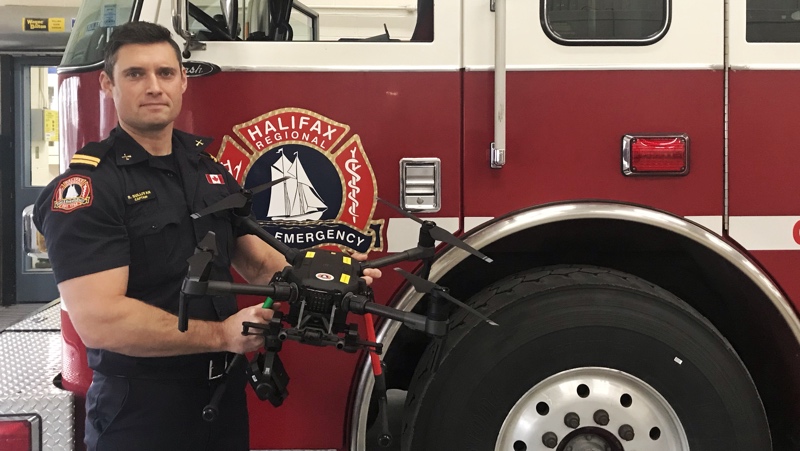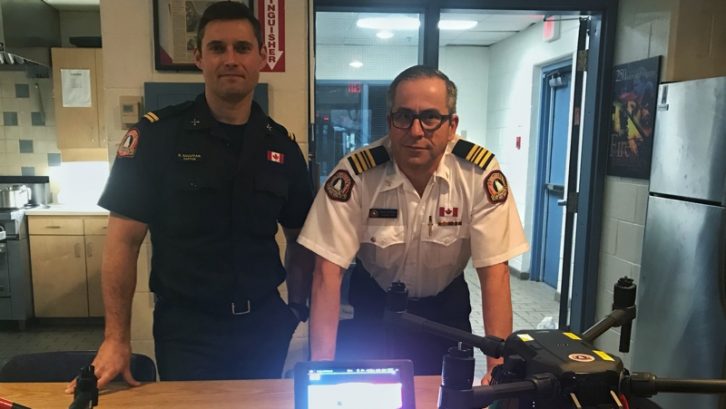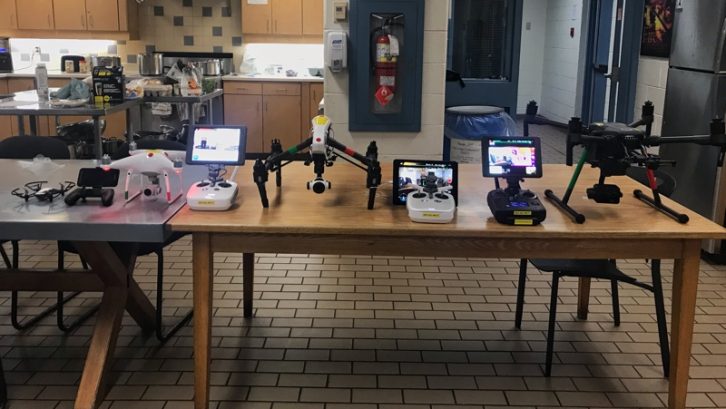Technology
Not just a toy: drones ‘a turning point’ for firefighters
Halifax Fire to buy another $10,000 drone

caption
Captain Richard Sullivan stands in front of a Highfield Park fire truck holding the department's Matrice 210 drone.It was a dark, cold December night when the search for a missing man was called off, but the fire crew took a chance. They sent up their new drone to look from another angle.
Using the drone’s thermal camera, they found the man semi-conscious under a Halifax bridge. They picked him up and rushed him to the hospital.
“I guess it’s up to anyone’s imagination what could have happened. There was an unconscious person, who had been in the environment for over three hours, laying on a cold, steel structure,” said Chief Chuck Bezanson, the flight manager of the Halifax Regional Municipality Fire and Emergency drone program.
That search was the first time the $10,000 drone had been used, as firefighters only started training with it earlier that day. Now Fire and Emergency wants another drone as a backup. They put out a tender request on Feb. 1.

caption
Captain Richard Sullivan (left) and Chief Chuck Bezanson (right) with the Halifax Fire and Emergency drones.Bezanson said the idea of spending money on drones has been met with some criticism. They may not put out fires, he said, but they help firefighters do their work and stay safe on the job.
“Firefighters take risks. That’s what we do and that’s what the public pays us to do, but they don’t pay us to take risk unnecessarily,” said Bezanson.
The drone, a Matrice 210, goes nearly 80 km/h and can be used in winds up to 77 km/h in all weather but freezing rain. Besides the thermal camera, it can zoom in to read a licence plate nearly three miles away, Bezanson said.
HRM Fire and Emergency has purchased four models of drones over the past two years, but none of the same quality or price range as the Matrice 210.
“We’re about to really delve into some great technology and it’s going to be a turning point for the fire department and the services it’s going to be able to offer,” said Capt. Richard Sullivan, a Highfield Park firefighter trained to use drones.
Firefighters can send drones to read a label on a suspicious package, detect leaks in hazardous material containers or look for the safest areas of a burning building.
Firefighters often go on the roofs of burning buildings to release smoke, said Bezanson. “Years gone by, we’ve gone on the roof and tapped it with an axe as we slowly moved along looking to see if it was soft. Well, sometimes they’re soft too quickly and people go through them.”
Luckily, Bezanson said, the firefighters he’s seen go through roofs have survived, but they can avoid it entirely with a drone.
Forest fire
In July, fire crews arrived to fight a Cole Harbour forest fire. From the ground, all they could tell was that the fire was large and moving fast.
Within about 10 minutes, they were able to get a drone with a thermal camera 400 feet in the air and identify the area at risk, the closest water supply and the best place for their equipment.
The fire was headed toward 10 homes.
Without the drone, “it most likely would have came out of the tree line in people’s backyards before we could find it,” Bezanson said. “It would have taken hours.”
$60,000 for drones
Regional council was initially concerned drones could infringe on people’s privacy, Bezanson said. But the drones only record video or take photos if firefighters choose to. The footage is then stored on a memory card that is kept private.
Fire and Emergency’s motion for $60,000 to be added to the capital budget for drones was passed in July 2016, after two previous attempts. Halifax Fire currently has four different models, ranging in size and price. The Matrice 210 is the biggest and most expensive.
The fire department already has cameras that cost $18,000 each for the Matrice 210. They would like more accessories, such as an arm that can pick up and put down objects.
Bezanson said the arm would allow first responders to get a life-jacket to someone in the water faster than getting in a boat and delivering it themselves. It could also hold a radiation meter that could be read remotely.
Bezanson said 18 firefighters in the HRM are trained to use drones and at least one trained firefighter is available during every shift.

caption
The four models of drones Halifax Fire and Emergency owns lined up at the Highfield Park Fire Station.The drones are kept at the Highfield Park fire station in Dartmouth. Other stations can request the drones be delivered or brought to emergency situations. Highfield houses a tactical support unit, a truck that goes out on almost every call.

